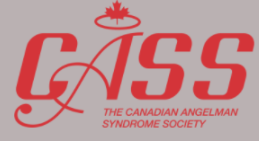Angelman Syndrome: Difference between revisions
No edit summary |
No edit summary |
||
| Line 1: | Line 1: | ||
== Description of Angelman Syndrome == | == Description of Angelman Syndrome *note: this is a student project that is still being completed == | ||
Complex genetic disorder affecting the nervous system. It is characterized by severe learning difficulties, motor dysfunction, seizure disorder, and often a happy, sociable disposition. | Complex genetic disorder affecting the nervous system. It is characterized by severe learning difficulties, motor dysfunction, seizure disorder, and often a happy, sociable disposition. | ||
| Line 55: | Line 55: | ||
== Clinical Guidelines for Angelman Syndrome <br> == | == Clinical Guidelines for Angelman Syndrome <br> == | ||
[[File:CASS Logo.png|thumb]] | |||
== Additional Resources | == Additional Resources == | ||
Canadian Angelman Syndrome Society: | |||
* Visit their webpage here [https://www.angelmancanada.org/] | |||
== References == | == References == | ||
<references />Margolis, Seth S., Gabrielle L. Sell, Mark A. Zbinden, and Lynne M. Bird. "Angelman syndrome." Neurotherapeutics 12, no. 3 (2015): 641-650. | <references />Margolis, Seth S., Gabrielle L. Sell, Mark A. Zbinden, and Lynne M. Bird. "Angelman syndrome." Neurotherapeutics 12, no. 3 (2015): 641-650. | ||
Revision as of 14:57, 3 May 2018
Description of Angelman Syndrome *note: this is a student project that is still being completed[edit | edit source]
Complex genetic disorder affecting the nervous system. It is characterized by severe learning difficulties, motor dysfunction, seizure disorder, and often a happy, sociable disposition.
Prevalence[edit | edit source]
Affects approximately 1 in 15,000 individuals (Margolis et al)
Epidemiology[edit | edit source]
- Onset is usually before the age of 3 (Margolis)
- Caused by 4 molecular mechanisms (Kishino)
- Maternal deletions of chromosome 15q11-q13 (70-80%)
- Intragenic mutation in maternally inherited UBE3A which is found in chromosome 15q11-q13 (10-20%)
- Paternal uniparental disomy (UPD) in chromosome 15q11-q13 (3-5%)
- Imprinting defects in chromosome 15q11-q13 which change the expression of UBE3A (3-5%)
- Those with deletion have more severe disease and those with UPD and imprinting have less severe defects (Margolis)
Clinical Presentation[edit | edit source]
- Observable Presentation
- Facial features - thin upper lip, wide spaced teeth
- Scoliosis (20% of children/50% adults) (reference from guidelines)
- Motor Presentation
- Motor dysfunction - tremors, jerkiness, ataxia
- Behavioural Presentation
- Developmental delay is normally seen within the first year of life
- most patients lack speech completely but those mildly affected can speak a few words
- Severe intellectual disability
- Hyperactivity and short attention span
- Mouthing of objects
- Happy demeanor with increased laughter, and often an attraction to water
- Developmental delay is normally seen within the first year of life
- Additional Comorbidities that present
- Seizures (60% of individuals)
- Autism spectrum disorder (ASD),
- Digestive system complications
- constipation
- gastroesophageal reflux
Diagnostic Procedures[edit | edit source]
Patients with Angelman Syndrome are often diagnosed within their first year of life. Diagnosis should be confirmed with genetic testing to determine DNA methylation (Margolis et al.)
Differential Diagnosis
[edit | edit source]
add text here relating to management approaches to the condition
Outcome Measures
[edit | edit source]
add text here relating to the differential diagnosis of this condition
Physiotherapy Management and Treatment
[edit | edit source]
text here
Additional Treatment
[edit | edit source]
Clinical Guidelines for Angelman Syndrome
[edit | edit source]
Additional Resources[edit | edit source]
Canadian Angelman Syndrome Society:
- Visit their webpage here [1]
References[edit | edit source]
Margolis, Seth S., Gabrielle L. Sell, Mark A. Zbinden, and Lynne M. Bird. "Angelman syndrome." Neurotherapeutics 12, no. 3 (2015): 641-650.







